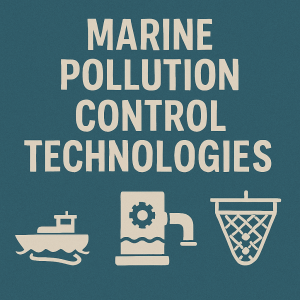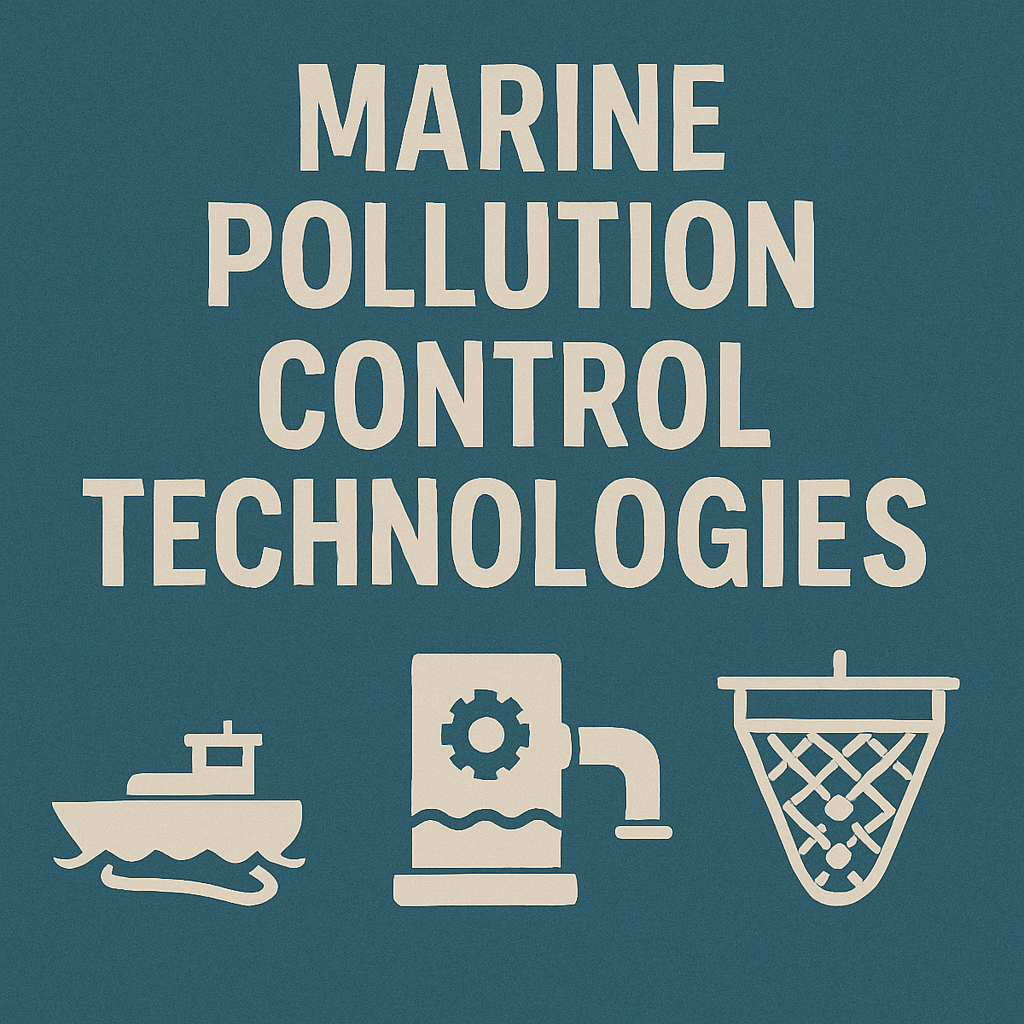Explore the latest marine pollution control technologies shaping the future of ocean sustainability. From ballast water treatment to AI-driven monitoring, discover how the maritime industry is tackling pollution at sea.
Why marine pollution control matters in modern maritime operations
 The world’s oceans, often romanticized as vast and invincible, are under unprecedented stress. From oil spills and sewage discharge to microplastics and ballast water contamination, marine pollution is an escalating global concern. According to the International Maritime Organization (IMO), shipping activities contribute significantly to ocean pollution. While regulation has improved, the scale of global trade—some 11 billion tons of goods transported by sea annually—demands robust marine pollution control technologies.
The world’s oceans, often romanticized as vast and invincible, are under unprecedented stress. From oil spills and sewage discharge to microplastics and ballast water contamination, marine pollution is an escalating global concern. According to the International Maritime Organization (IMO), shipping activities contribute significantly to ocean pollution. While regulation has improved, the scale of global trade—some 11 billion tons of goods transported by sea annually—demands robust marine pollution control technologies.
For seafarers, port authorities, shipowners, and marine engineers, understanding these technologies isn’t just technical knowledge—it’s a frontline defense for environmental stewardship. With the ocean producing over 50% of the world’s oxygen and absorbing about 30% of carbon dioxide emissions (UNESCO), the maritime sector holds an ethical and legal responsibility to reduce its footprint.
Key technologies and developments driving change
Modern marine pollution control is no longer limited to oil booms and chemical dispersants. It’s a sophisticated, multi-layered ecosystem of technologies, monitoring systems, and regulatory frameworks.
Ballast Water Treatment Systems (BWTS)
Ballast water, critical for vessel stability, can carry invasive aquatic species across continents. The IMO’s Ballast Water Management Convention (2017) mandates vessels to install treatment systems that neutralize or remove harmful organisms.
Technologies include:
- UV radiation systems: These sterilize organisms without harmful chemicals.
- Electrochlorination: Using seawater electrolysis to generate disinfectants.
- Filtration & chemical dosing: Common in Wärtsilä and Alfa Laval systems.
As of 2024, over 60,000 ships globally are estimated to have some form of BWTS installed (Clarksons Research).
Exhaust Gas Cleaning Systems (Scrubbers)
To comply with the IMO 2020 Sulphur Cap, ships either switch to low-sulphur fuels or install exhaust gas cleaning systems.
- Open-loop scrubbers discharge treated water into the sea, raising environmental debates.
- Closed-loop systems retain scrubber washwater onboard for disposal at port.
- Hybrid systems combine both.
Despite criticism, scrubbers remain widely adopted. According to DNV, over 4,000 ships had scrubbers installed by mid-2023.
Oil Spill Detection and Response Tools
Oil pollution is one of the most visible and destructive forms of marine contamination. Modern tools include:
- Aerial drones and satellite imaging to detect slicks early.
- AI-based modeling to predict spill drift and dispersion.
- Containment booms with GPS tracking for precision deployment.
Case in point: The use of AI-based spill detection off the Norwegian coast reduced average spill response time by 35%, according to a 2022 report by SINTEF.
Sewage and Greywater Treatment Units
Under MARPOL Annex IV, ships must treat sewage to a high standard before discharge. Modern treatment plants onboard use:
- Biological treatment with activated sludge.
- Membrane bioreactors (MBR) for filtration.
- Chlorination and UV sterilization for pathogens.
Some cruise lines, like those under the CLIA, are investing in advanced wastewater purification systems that exceed IMO requirements.
Plastic Waste and Garbage Compactors
With 8–12 million metric tons of plastic entering oceans annually (UNEP), onboard waste handling is a major focus. Ships now deploy:
- Plastic shredders and compactors.
- Incinerators with emission controls.
- Segregated recycling bins as per MARPOL Annex V.
AI, IoT, and Smart Monitoring Systems
A growing trend is digital pollution monitoring:
- Smart sensors track discharge data in real time.
- AI platforms predict potential non-compliance events.
- Digital twins simulate environmental impacts of operations.
Ports like Rotterdam and Singapore are integrating smart marine tech with vessel tracking and pollution oversight.
–
Challenges and solutions
Complex regulations and inconsistent enforcement
While the IMO provides global guidance, enforcement is often left to flag states and port authorities. This creates inconsistencies in implementation. To address this, regional cooperation (e.g., the Paris MoU) and electronic inspection databases like IMO GISIS are gaining traction.
Cost and retrofitting hurdles
Installing BWTS or scrubbers on older ships can cost between USD 1–5 million. Not all shipowners, especially in developing nations, can afford such upgrades.
Solutions:
- Financial incentives from the Green Shipping Challenge.
- Carbon credit systems and tax relief for compliant vessels.
Technological reliability at sea
Marine systems must operate in saltwater, turbulence, and temperature extremes. Malfunctioning scrubbers or BWTS can pose risks.
Innovation is closing the gap: class societies like ABS and Bureau Veritas are conducting digital twin trials and risk-based design evaluations to increase system resilience.
Future outlook
The future of marine pollution control will likely be shaped by stricter IMO targets (like GHG reduction by 50% by 2050), green fuels (like ammonia and methanol), and autonomous ship technologies.
Emerging trends:
- Biofouling control tech: Using non-toxic coatings and ultrasonic cleaning.
- Onboard carbon capture and storage (CCS): Piloted on LNG and bulk carriers.
- Smart compliance dashboards: Real-time emissions and waste tracking.
By 2030, it’s estimated that nearly 70% of the global fleet will feature at least one digital pollution mitigation system, according to the WMU Journal of Maritime Affairs.
–
Real-world applications and case studies
- Maersk invested over $1.5 billion in clean technology, retrofitting older ships with hybrid scrubbers and advanced water treatment units.
- Royal Caribbean’s Symphony of the Seas is equipped with MBR sewage treatment and zero-discharge policies in sensitive areas like Alaska.
- Norway’s Green Shipping Programme tests onboard AI emissions tracking with Wärtsilä.
These pioneers demonstrate how technology and commitment can reduce maritime environmental harm significantly.
FAQ
What is the biggest source of marine pollution from ships? Oil discharge, sewage, garbage, and air emissions are key contributors. Ballast water also spreads invasive species.
Is ballast water treatment mandatory? Yes. Under the IMO Ballast Water Management Convention, treatment systems are required for most international vessels.
Do scrubbers harm the environment? Open-loop scrubbers can discharge acidic water. That’s why several countries, including China and Germany, have restricted their use in ports.
Are there penalties for non-compliance? Yes. Port State Control can detain vessels, fine shipowners, or ban entry into ports for repeated violations.
What’s the role of AI in pollution control? AI is used for monitoring emissions, predicting spills, and optimizing waste treatment operations in real time.
How do smaller ships manage pollution control? They typically rely on compact, modular systems. MARPOL rules also vary by vessel size and trading area.
Conclusion
Marine pollution control technologies are evolving quickly—from chemical treatment to digital intelligence. As regulations tighten and public awareness grows, shipowners and maritime professionals must stay ahead with smart, reliable, and future-ready systems.
For maritime students and young professionals, now is the time to engage with this growing field. Whether through engineering, environmental policy, or data science, the future of marine pollution control is an ocean of opportunity.
Let’s protect our oceans—one innovation at a time.
References
- International Maritime Organization (IMO). https://www.imo.org
- United Nations Educational, Scientific and Cultural Organization (UNESCO). https://oceanliteracy.unesco.org
- Clarksons Research. https://www.clarksons.net
- SINTEF Report on Oil Spill Detection. https://www.sintef.no/en
- United Nations Environment Programme (UNEP). https://www.unep.org
- WMU Journal of Maritime Affairs. https://link.springer.com/journal/13437
- Paris MoU. https://www.parismou.org
- Inmarsat Green Shipping Challenge. https://www.un.org/en/climatechange/cop27/green-shipping-challenge
- Wärtsilä Marine. https://www.wartsila.com
- Alfa Laval Ballast Systems. https://www.alfalaval.com
- IMO GISIS Platform. https://gisis.imo.org

